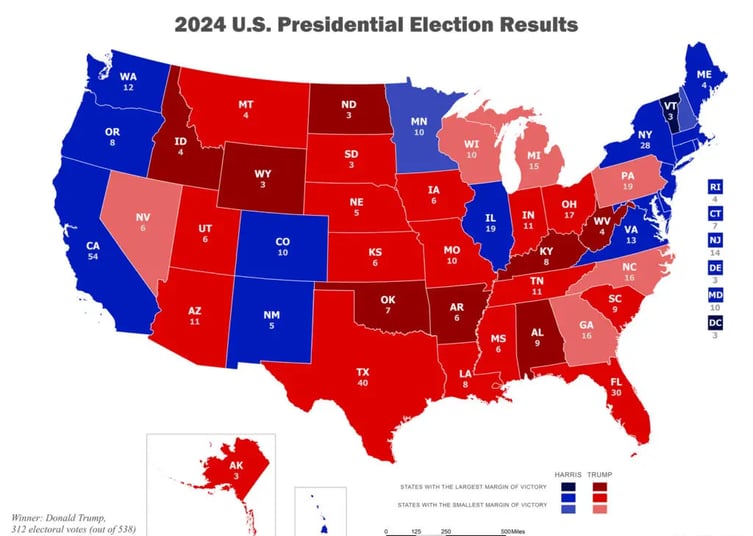Donald Trump’s 2024 election victory, while being a significant political comeback, does not meet the historical standards of a "landslide" or "mandate" when compared to past elections with those descriptors.
Breakdown of Trump’s 2024 Results:
Electoral College: Trump secured 312 electoral votes, surpassing his own 2016 victory (306) and Biden's 2020 win (306). However, it falls short of more decisive victories such as Barack Obama’s 365 votes in 2008 or Ronald Reagan's 525 votes in 1984.
Popular Vote: Trump won approximately 74.5 million votes, a marginal increase from his 2020 total of 74 million. In comparison, Obama won over 69 million in 2008 with 365 electoral votes, indicating a stronger mandate relative to turn out and vote distribution
.
Historical Landslides for Context:
Reagan (1984): Won 525 electoral votes, losing only Minnesota and DC, with over 58% of the popular vote.
Nixon (1972): Secured 520 electoral votes and over 60% of the popular vote.
Johnson (1964): Garnered 486 electoral votes and more than 61% of the popular vote
Assessment of "Mandate" Claims:
While Trump has claimed an “unprecedented mandate,” his electoral performance was robust but not extraordinary by historical standards. It does reflect a shift in certain battleground states, reinforcing his base but lacking the sweeping national consensus seen in historical landslides
Trump’s win signifies a solid Republican realignment but not the type of overwhelming public endorsement typical of a mandate or landslide victory in U.S. electoral history.
In the 2024 election, Trump flipped several states that had supported Biden in 2020, contributing to his overall victory. Some of the most significant states that Trump won in 2024 but lost in 2020 include:
Georgia (16 electoral votes)
Arizona (11 electoral votes)
Pennsylvania (19 electoral votes, down from 20)
Michigan (15 electoral votes, down from 16)
Nevada (6 electoral votes)
Wisconsin (10 electoral votes)
In these states, Trump improved his margin compared to 2020, often by narrow but decisive margins. Additionally, he performed better in traditionally red states, further solidifying his base
geographical shift also reflected stronger support in the Sun Belt, while the Rust Belt saw declines in influence. These changes contributed to Trump's narrower but still significant victory in the Electoral College.

